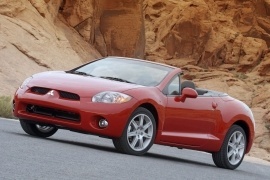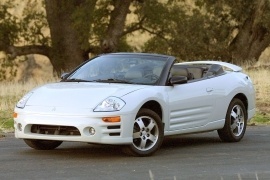
MITSUBISHI Eclipse Spyder
Generations Timeline, Specs and Pictures

The fourth generation of the Eclipse appeared in 2005, and the carmaker waited another two years before introducing the open-top version and refreshed the lineup four years later.
With the world financial crisis gone and the market started to go up again, Mitsubishi was eager to recover the money it lost. Its spyder version was one of the vehicles that were built to get money since it used an already developed platform.
There were a few improvements that worth on the 2009 Eclipse Spyder. At the front, the big grille divided by a black element of the bumper looked like a wind-tunnel with a silver badge on it. The mesh design only accentuated that, while the bigger headlights tried to be convincing that they deserved to be on a sports roadster. On its sides, the rear quarter panels were slightly enlarged, showing a muscular line. For the rag-top, Mitsubishi developed a power-system that could cover or uncover the cabin in 19 seconds. It featured a glass rear defroster window.
Inside, the sport bucket-seats with integrated headrests featured high-bolstered sides to keep their occupants in place during high cornering. In the back, it was enough room for very small children or a few bags of shopping. The Spyder was not a sports car anymore. It was more of an affordable sporty open-top vehicle.
Under the hood, the carmaker installed front-wheel-drive powertrains with a choice of two engines. The base version featured a 2.4-liter inline-four, while the other option was a 3.8-liter V-6, too heavy for the car’s front but powerful enough to get to 209 kph (130 mph). Both versions were paired to a five-speed automatic transmission.

Mitsubishi introduced in 2006 the fourth generation of the Eclipse as a coupe or a convertible, which was named Spyder.
While the first two Eclipse generations built a big fan base around them thanks to the all-wheel-drive and turbocharged engines, their successors were less successful, heavier, and slower. The only good part was that they came with V-6 engines under the hood. Mitsubishi built it on a Galant platform, and that was not the best idea for a sports coupe or convertible.
The Japanese carmaker tried to get rid of the boy-racer status it gained with its first three generations and tried to evolve into a mature, open-top near-premium coupe and convertible. That’s why the fourth Eclipse generation didn’t look that aggressive anymore. Its rounded shapes were part of the bio-design trend, which was already dead when the 2007 Eclipse Spyder came on the market. With its rag-top up, the car had wide blind spots and a narrow rear windscreen. But, at least, the canvas roof was completely retractable under a special cover placed behind the rear seats.
Inside, the Eclipse Spyder offered seating for four, with sport bucket seats at the front that offered good side support. Their design reminded of boy-racer cars, not by more upmarket convertibles. The Eclipse featured a symmetrical cockpit. Although functional, the interior’s design was rather dull, and the aluminum pedals were just not enough to save the appearance.
Under the hood, the carmaker offered the Spyder a choice of two engines: a 2.4-liter inline-four and a 3.8-liter V-6, both developed by Mitsubishi. It was the last Eclipse Coupe and Spyder generation.

Sporting a soft-top and a slightly higher drag coefficient than the coupe, the Spyder shared the same features.
Available with the base GS, mid GT and high-end GTS trims, the Spyder comes with a choice of three gasoline engines ranging in output from 152 hp to 210 hp. Despite its overall good performance, the Spyder had the same fate as the coupe and saw the removal of the 4-wheel drive option from the GTS trim. The latter came with a superior engine equipped with a Variable Induction Management (VIM) air intake thanks to which the power output was boosted by 10 hp.























































